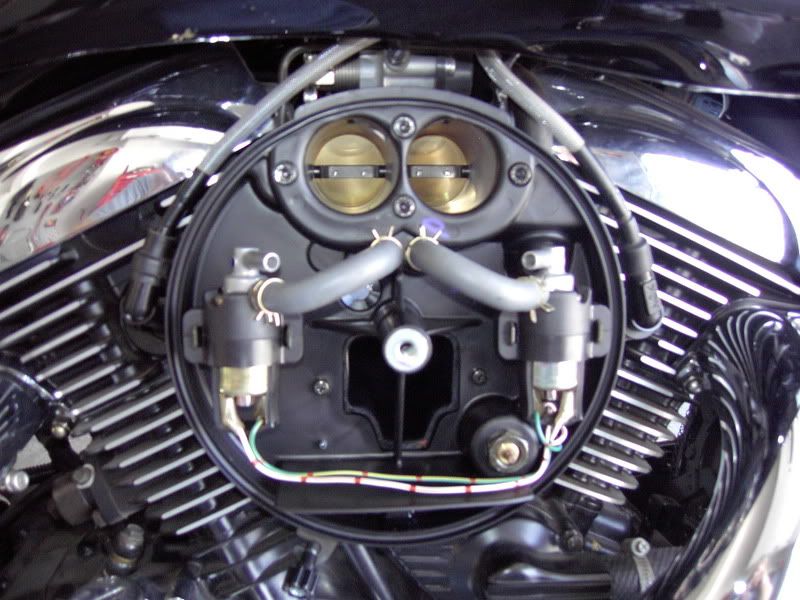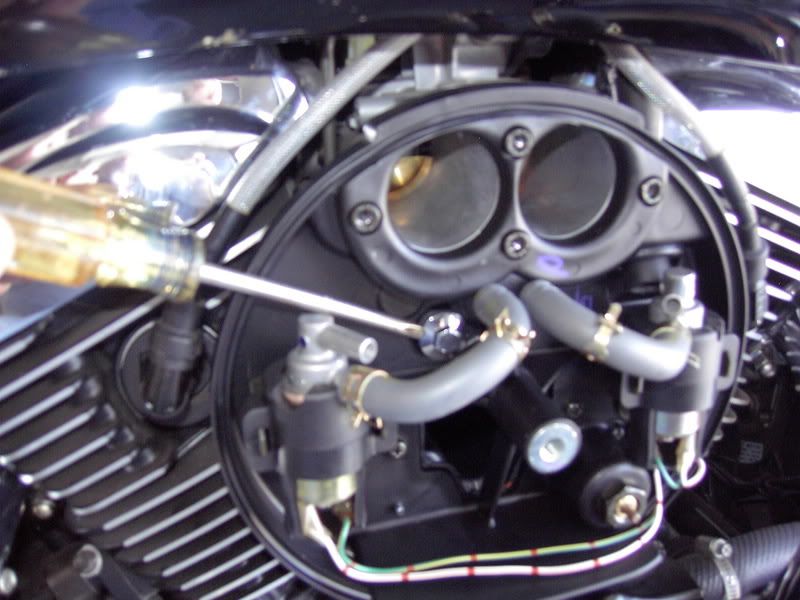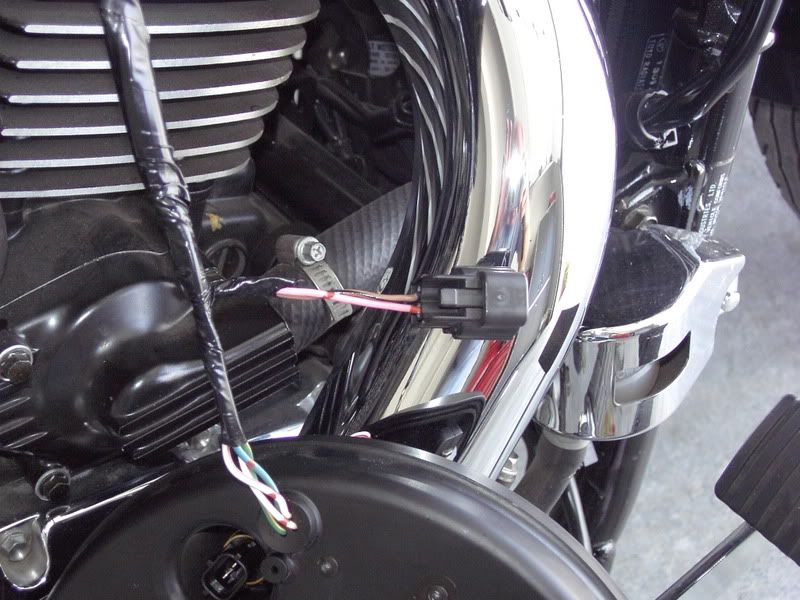Reducing Vulcan V-Twin Engine Noise with a Resistor
It has been documented and discussed here in this forum as well as most other Vulcan forums that due to a variety of factors the lean nature of these bikes makes them prone to knocking/pinging.
Curiosity finally got the best of me and I decided to take a shot at trying to quiet this bike down. As I understand it the “CF” (commotion factor) varies from bike to bike. My particular steed is a 2004 Marauder 1600 and after having ridden bikes for approaching 40 years it was without a doubt the noisiest motored 2 wheeler I’ve ever had the pleasure? to own.
I installed cooler plugs shortly after picking the bike up and that helped a great deal. I’ve also experimented with different grades and brands of gasoline as well as a variety of additives. The use of a the premium QT fuel in combination with an octane booster also provided some additional relief from the commotion but the bottom line was that it annoyed me to have yet another Kawasaki motored bike that made so darn much noise.
It appeared that the simplest and most cost effective solution would be the resistor “fix” that is covered in detail in the following article:
Pre-Ignition Fix For Fuel Injected Motorcycles
I should probably note that the other solution that I seriously considered was the adjusting of the TPS that appeared in my mind to be an even better solution but it also looked somewhat more involved. Given my time constraints the day I attempted this project I opted to go with the resistor solution instead as it is completely reversible and that such an approach would allow me to adjust the TPS at sometime in the future to see how the two different approaches would stack up next to each other.
On the right side of the bike you’ll find the following:
![Image]()
The temperature sensor is the brass colored item which is located at approximately the 4:00 position in the above photo. To get access to the wiring the four allen bolts (5 mm) will need to be removed as well as the two Philips headed screws. Once those are removed the only other item is the 10 mm headed bolt that can just barely be seen behind the left hose.
Below is another shot that gives a better view of that bolt:
![Image]()
After removing those items you’ll have access to the plug that is attached to the temperature sensor. When pulled loose it will look like this:
![Image]()
This is where the resistor is placed. As noted by others I had picked up a package of 1K (1000) Ohm resistors at Radio Shack. I won’t go into a lot of details as that has been covered before but the results are well worth the time. I did mine during a lunch hour and then took it out for a quick test run. Where I used to hear all kinds of commotion things were quiet and smooth. I rolled down the street and turned around, I actually had to try to get the bike to ping at all. At the time of these first trial runs it was well over 90 degrees with the humidity driving the heat index to at least 97 degrees.
Later that evening we went for a group ride. Diana and I covered right at 70 miles two-up over a variety of conditions and roads. Again I can make it ping if I work at it but it is clearly a 90% improvement over the pre-resistor state. This weekend we went out again with Diana on here Rebel and myself on the Marauder. Again, the difference in CF is nothing short of amazing!!
Knowing what I now know...I'm not sure why I put up with this rattling and pinging so darn long. Number two is that it really is an easy "fix" if a person has a little mechanical ability and is even semi-capable with the soldering iron. With this in mind doing it again to try another resistor wouldn't be that big of a deal. Nevertheless, given some recent updates I'd be very tempted to try the 2.2K resistor fix knowing that worse case scenario is that you you might have to pull it and go for a lesser value.
My future plans are to pull the 1K resistor and try the 2.2K just to see what if any differences this change makes. Post that I’d like to put the temperature sensor back to the stock setting and try the TPS adjustment. Once I’ve documented that change I’d like to move forward with some intake air management enhancements and depending upon my findings I may even take a shot at a resistor or TPS adjustment to get the proper mixture as opposed to moving forward with some type of aftermarket FI management device. If I’m unable to make that solution work the worst case scenario is that I’m out a little time and I’ll pick up an FI management system.
To all who wish to attempt such a project, just take your time and think before you do. Good Luck!!
Ride safe and often,
Don
It has been documented and discussed here in this forum as well as most other Vulcan forums that due to a variety of factors the lean nature of these bikes makes them prone to knocking/pinging.
Curiosity finally got the best of me and I decided to take a shot at trying to quiet this bike down. As I understand it the “CF” (commotion factor) varies from bike to bike. My particular steed is a 2004 Marauder 1600 and after having ridden bikes for approaching 40 years it was without a doubt the noisiest motored 2 wheeler I’ve ever had the pleasure? to own.
I installed cooler plugs shortly after picking the bike up and that helped a great deal. I’ve also experimented with different grades and brands of gasoline as well as a variety of additives. The use of a the premium QT fuel in combination with an octane booster also provided some additional relief from the commotion but the bottom line was that it annoyed me to have yet another Kawasaki motored bike that made so darn much noise.
It appeared that the simplest and most cost effective solution would be the resistor “fix” that is covered in detail in the following article:
Pre-Ignition Fix For Fuel Injected Motorcycles
I should probably note that the other solution that I seriously considered was the adjusting of the TPS that appeared in my mind to be an even better solution but it also looked somewhat more involved. Given my time constraints the day I attempted this project I opted to go with the resistor solution instead as it is completely reversible and that such an approach would allow me to adjust the TPS at sometime in the future to see how the two different approaches would stack up next to each other.
On the right side of the bike you’ll find the following:

The temperature sensor is the brass colored item which is located at approximately the 4:00 position in the above photo. To get access to the wiring the four allen bolts (5 mm) will need to be removed as well as the two Philips headed screws. Once those are removed the only other item is the 10 mm headed bolt that can just barely be seen behind the left hose.
Below is another shot that gives a better view of that bolt:

After removing those items you’ll have access to the plug that is attached to the temperature sensor. When pulled loose it will look like this:

This is where the resistor is placed. As noted by others I had picked up a package of 1K (1000) Ohm resistors at Radio Shack. I won’t go into a lot of details as that has been covered before but the results are well worth the time. I did mine during a lunch hour and then took it out for a quick test run. Where I used to hear all kinds of commotion things were quiet and smooth. I rolled down the street and turned around, I actually had to try to get the bike to ping at all. At the time of these first trial runs it was well over 90 degrees with the humidity driving the heat index to at least 97 degrees.
Later that evening we went for a group ride. Diana and I covered right at 70 miles two-up over a variety of conditions and roads. Again I can make it ping if I work at it but it is clearly a 90% improvement over the pre-resistor state. This weekend we went out again with Diana on here Rebel and myself on the Marauder. Again, the difference in CF is nothing short of amazing!!
Knowing what I now know...I'm not sure why I put up with this rattling and pinging so darn long. Number two is that it really is an easy "fix" if a person has a little mechanical ability and is even semi-capable with the soldering iron. With this in mind doing it again to try another resistor wouldn't be that big of a deal. Nevertheless, given some recent updates I'd be very tempted to try the 2.2K resistor fix knowing that worse case scenario is that you you might have to pull it and go for a lesser value.
My future plans are to pull the 1K resistor and try the 2.2K just to see what if any differences this change makes. Post that I’d like to put the temperature sensor back to the stock setting and try the TPS adjustment. Once I’ve documented that change I’d like to move forward with some intake air management enhancements and depending upon my findings I may even take a shot at a resistor or TPS adjustment to get the proper mixture as opposed to moving forward with some type of aftermarket FI management device. If I’m unable to make that solution work the worst case scenario is that I’m out a little time and I’ll pick up an FI management system.
To all who wish to attempt such a project, just take your time and think before you do. Good Luck!!
Ride safe and often,
Don




